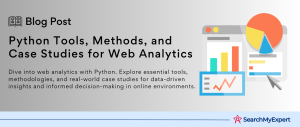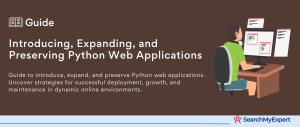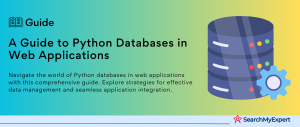Why Choose Python for Web Development: Unpacking Its Growing Popularity and Advantages
In the ever-evolving landscape of web development, Python has emerged as a frontrunner, captivating developers with its simplicity, versatility, and extensive range of libraries. This powerful programming language has steadily climbed the ranks, not just in popularity but in practicality, making it an ideal choice for both beginners and seasoned developers. Here’s a deep dive into why Python is a top pick for web development.
The Rise of Python: A Trendsetting Language in Web Development
Python’s surge in popularity isn’t coincidental. Its straightforward syntax and readability make it a favorite among developers who appreciate efficiency and ease of learning. Unlike other programming languages that may require verbose code, Python’s simplicity allows developers to write fewer lines of code for the same task, making it more efficient and less time-consuming.
Python’s Versatility: A One-Stop Solution
One of Python’s standout features is its versatility. It’s not just limited to web development; Python is used in a range of fields, from data science to artificial intelligence, making it a multi-faceted tool in a developer’s arsenal. This adaptability means that learning Python opens doors to various domains, not just web development.
A Treasure Trove of Libraries and Frameworks
Python’s extensive libraries and frameworks like Django and Flask have revolutionized web development. These tools offer pre-written code, which saves developers a significant amount of time and effort. Whether it’s building a simple website or a complex web application, Python’s libraries and frameworks have got you covered.
Basic Web Development Concepts: Understanding the Foundations
Before delving deeper into Python’s role in web development, it’s crucial to grasp some basic web development concepts. These include the client-server model, HTML, CSS, and JavaScript – the core components that make up the structure, design, and functionality of websites.
Getting Started with Python for Web Development: Setting the Stage for Success
Embarking on your web development journey with Python is an exciting venture. To ensure a smooth start, it’s crucial to set up your development environment correctly. This involves installing the Python interpreter, setting up virtual environments, and choosing the right text editor or Integrated Development Environment (IDE). Let’s break down these steps to get you up and running with Python.
Installing the Python Interpreter
Before diving into coding, the first step is to install the Python interpreter on your computer. Python is widely compatible, running on Windows, macOS, and Linux. Here’s how you can install it:
- Visit the official Python website (python.org) and navigate to the Downloads section.
- Select the version suited for your operating system. Python 3.x is recommended as it’s the latest and most supported version.
- Follow the installation instructions specific to your operating system. Remember to check the box that says “Add Python to PATH” during installation to ensure that Python is easily accessible from your command line or terminal.
Understanding and Setting Up Virtual Environments
Virtual environments in Python are essential, especially in web development. They allow you to manage separate package installations for different projects, ensuring that there are no conflicts between package versions across projects. To create a virtual environment:
- Open your command line or terminal.
- Navigate to your project directory.
- Run the command python -m venv myenv (replace ‘myenv’ with your preferred environment name).
- Activate the virtual environment using source myenv/bin/activate on macOS/Linux or myenv\Scripts\activate on Windows.
Choosing a Text Editor or an IDE
Selecting the right text editor or IDE can significantly impact your coding efficiency. For beginners, simple text editors like Sublime Text or Atom are great choices. They are lightweight and user-friendly. For those looking for more comprehensive tools, IDEs like PyCharm or Visual Studio Code offer advanced features like debugging tools, code suggestions, and integrations with other software.
Programming Fundamentals in Python: The Essentials for Web Development
Mastering the basics of programming is a critical step on the path to becoming a proficient Python web developer. This includes understanding the fundamental data types and their operations, grasping the concept of control flow with conditional statements and loops, and recognizing the importance of functions for efficient and reusable code.
Data Types: The Alphabet of Python Programming
Python’s data types are the fundamental categories of data that define the operations that can be done on them and the storage method for each of them. Understanding these types is essential for efficient data manipulation and processing in web development.
- Integers and Floats: These are the primary types for numerical data. Integers are used for whole numbers, while floats are used for numbers with decimal points. Operations like arithmetic calculations are commonly performed on these types.
- Strings:
Strings are sequences of characters and are used to handle text data in Python. From webpage content to user inputs, strings play a crucial role in web development. - Booleans: This type represents two values: True and False. Booleans are fundamental in control flow constructs and decision-making in programs.
- Lists:
Lists are versatile and can contain items of different data types. They are mutable, meaning you can change their content without changing their identity. In web development, lists can be used to store sequences of data like user information or search results. - Dictionaries:
Dictionaries store data in key-value pairs and are crucial for handling more complex data structures like JSON, which is widely used in web applications for data exchange.
Control Flow: Directing the Course of Your Program
Control flow in programming refers to the order in which the code is executed. In Python, this is primarily handled through conditional statements and loops, which are fundamental for developing dynamic websites.
- Conditional Statements (if/else): These statements allow you to execute certain parts of code depending on whether a specific condition is true or false. This is particularly useful in handling user inputs or making decisions in your web application.
- Loops (for/while): Loops are used to repeat a block of code multiple times. ‘For’ loops are typically used when you know in advance how many times you want to execute a block of code, whereas ‘while’ loops are used when you want to repeat something until a certain condition is met. They are particularly useful for tasks like processing items in a list or generating repetitive HTML structures.
Functions: Building Blocks of Reusable Code
Functions in Python are defined blocks of code designed to perform a specific task. They enhance code reusability, make your code more organized, and help to keep your code DRY (Don’t Repeat Yourself).
- Understanding Functions: A function is defined using the def keyword, followed by a name, parameters, and a block of code. It performs a task and usually returns a result.
- Parameter Passing and Return Values:
Functions can take parameters, which are inputs that you can pass to the function to change how it behaves. They can also return values, which are the results of the function’s operations. - Importance in Web Development: In web development, functions play a crucial role, from processing user input to querying databases and rendering content. They allow for cleaner, more modular, and maintainable code, which is essential for complex web applications..
Web Development with Python: Bridging Front-End and Back-End
Python, renowned for its simplicity and efficiency, plays a pivotal role in both front-end and back-end web development. This versatility enables Python to seamlessly integrate with front-end elements and robustly manage server-side operations.
Front-End Integration: Python’s Role in Crafting User Interfaces
While Python is not traditionally used for front-end development, it significantly contributes to this aspect through its libraries that aid in templating and generating HTML and CSS.
- Python Templating Libraries: Libraries like Jinja2 and Mako allow for the integration of Python with HTML. They provide a powerful yet intuitive template engine to dynamically generate HTML files. This is particularly useful for creating web pages with content that changes depending on user input or other factors.
- Generating HTML/CSS:
Through these libraries, Python can be used to programmatically generate HTML and CSS. This method is especially beneficial for creating repetitive or dynamically changing web page elements. - Enhancing User Experience: By using Python for templating, developers can create more interactive, dynamic, and personalized web pages that enhance user experience.
Back-End Development: Python’s Server-Side Prowess
Python’s real strength in web development lies in its capacity for server-side scripting. This involves handling HTTP requests, responding with data, and interacting with databases – the core functionalities of any web application.
- Server-Side Scripting: Python frameworks like Django and Flask are widely used for server-side scripting. They handle the backend logic of web applications, processing client requests received via HTTP.
- Handling Requests and Responses: In server-side scripting, Python scripts process the data sent by a client and determine what should be sent back. This could involve querying a database, processing user input, or performing calculations.
- Database Interaction:
Python, with libraries such as SQLAlchemy and Django ORM, provides seamless interaction with databases. It can manage database operations like querying, updating, and deleting data, which are crucial for dynamic websites. - Robust Frameworks: Python’s Django and Flask frameworks are particularly popular for back-end development. Django, known for its “batteries-included” approach, provides a comprehensive suite of tools and features for rapid web development. Flask, on the other hand, offers more flexibility and is suitable for smaller projects and microservices.
Web Development with Python: Bridging Front-End and Back-End
Python, renowned for its simplicity and efficiency, plays a pivotal role in both front-end and back-end web development. This versatility enables Python to seamlessly integrate with front-end elements and robustly manage server-side operations.
Front-End Integration: Python’s Role in Crafting User Interfaces
While Python is not traditionally used for front-end development, it significantly contributes to this aspect through its libraries that aid in templating and generating HTML and CSS.
- Python Templating Libraries:
Libraries like Jinja2 and Mako allow for the integration of Python with HTML. They provide a powerful yet intuitive template engine to dynamically generate HTML files. This is particularly useful for creating web pages with content that changes depending on user input or other factors. - Generating HTML/CSS: Through these libraries, Python can be used to programmatically generate HTML and CSS. This method is especially beneficial for creating repetitive or dynamically changing web page elements.
- Enhancing User Experience: By using Python for templating, developers can create more interactive, dynamic, and personalized web pages that enhance user experience.
Back-End Development: Python’s Server-Side Prowess
Python’s real strength in web development lies in its capacity for server-side scripting. This involves handling HTTP requests, responding with data, and interacting with databases – the core functionalities of any web application.
- Server-Side Scripting: Python frameworks like Django and Flask are widely used for server-side scripting. They handle the backend logic of web applications, processing client requests received via HTTP.
- Handling Requests and Responses: In server-side scripting, Python scripts process the data sent by a client and determine what should be sent back. This could involve querying a database, processing user input, or performing calculations.
- Database Interaction:
Python, with libraries such as SQLAlchemy and Django ORM, provides seamless interaction with databases. It can manage database operations like querying, updating, and deleting data, which are crucial for dynamic websites. - Robust Frameworks:
Python’s Django and Flask frameworks are particularly popular for back-end development. Django, known for its “batteries-included” approach, provides a comprehensive suite of tools and features for rapid web development. Flask, on the other hand, offers more flexibility and is suitable for smaller projects and microservices.
Popular Python Web Frameworks: The Powerhouses of Web Development
Python’s versatility in web development is largely attributed to its robust frameworks. These frameworks simplify the development process, offering tools and libraries that make it easier to build efficient and scalable web applications. Let’s explore some of the most popular Python web frameworks: Django, Flask, and Bottle, highlighting their strengths and ideal use cases.
Django: The All-in-One Framework
- Overview:
Django, often described as a “batteries-included” framework, provides a comprehensive solution for web development. It’s designed to help developers build complex, data-driven websites quickly and with less code. - Strengths:
It includes an ORM (Object-Relational Mapping) system, admin panel, and a templating engine. Django is known for its robust security features and scalability. - Target Use Cases: Ideal for larger applications or when you need to implement complex functionalities like content management systems, scientific computing platforms, or large-scale social networks.
Flask: The Microframework
- Overview:
Flask is a lightweight and flexible microframework that is perfect for smaller projects or when more control is required. It is minimalist but highly extensible. - Strengths: Flask provides the basics of web development, giving you more freedom to use the tools and libraries you prefer. It’s known for being easy to learn and for its flexibility.
- Target Use Cases: Best for smaller projects, microservices, or when learning the basics of web development. Flask is also a good choice for projects that require a custom or specialized solution.
Bottle: Simplicity and Efficiency
- Overview: Bottle is another microframework, but it’s even more lightweight than Flask. It’s a single-file framework designed for building simple web applications.
- Strengths:
It is known for its simplicity and efficiency. Bottle is easy to deploy and doesn’t require any dependencies apart from the Python Standard Library. - Target Use Cases:
Suitable for building small web applications, personal projects, or prototyping. Bottle is also used for building simple web services or APIs.
Basic Framework Structure: Simplified Web Application Example
Each of these frameworks follows a model-view-controller (MVC) architecture, but they implement it in different ways. Here’s a simplified example of a typical structure in a Python web framework:
- Routing:
This involves defining URLs (or routes) and associating them with specific functions in your application. These functions are triggered when a user visits the URL. - Request Handling:
Each route is associated with a function that handles requests and returns responses. This function, often called a view, processes data, interacts with a database, and renders templates. - Templates:
These are HTML files with placeholders for dynamic content. The view functions populate these placeholders with actual data to be presented to the user. - Models: In frameworks with ORM, models represent database tables. They allow you to interact with the database in an object-oriented way.
Resources and Next Steps: Expanding Your Python Web Development Skills
After diving into the basics of Python and its application in web development, it’s time to explore further learning resources and embark on some beginner-friendly projects. Here are some curated resources and project ideas to enhance your skills and apply your new knowledge.
Learning Resources
Online Tutorials and Courses:
- Codecademy offers interactive Python courses tailored to web development.
- Udemy and Coursera feature comprehensive courses on Python web frameworks like Django and Flask, suitable for all skill levels.
Official Documentation:
- Python.org: Start with the official Python documentation for in-depth understanding.
- DjangoProject.com and Flask.palletsprojects.com:
Explore these sites for official Django and Flask documentation, respectively.
Communities and Forums:
- Stack Overflow:
A great platform for getting answers to specific programming questions. - Reddit communities such as r/learnpython and r/webdev offer support, advice, and insights from fellow learners and experienced developers.
- GitHub:
Engage with the open-source community and contribute to projects to understand real-world applications.
Blogs and YouTube Channels:
- Real Python and Full Stack Python are excellent blogs for learning tips, tricks, and best practices.
- YouTube channels like Corey Schafer and Traversy Media offer detailed tutorials and project walkthroughs.
Project Ideas
- Personal Portfolio Website:
Use Flask or Django to build a personal website showcasing your projects, resume, and blog posts. This project will give you practical experience in routing, template rendering, and possibly database integration. - Blog Application:
Create a simple blog where users can post, edit, and delete articles. This project will help you understand user authentication, database operations, and front-end integration. - To-Do List Application: Develop a web-based to-do list where users can add, edit, and delete tasks. This is a great beginner project to understand the basics of CRUD (Create, Read, Update, Delete) operations in web development.
- Weather App:
Create an application that fetches weather data from an API and displays it. This project can introduce you to working with external APIs and JSON data. - E-commerce Site (Advanced): For a more challenging project, try building a simple e-commerce site with product listings, a shopping cart, and an order management system. This will deepen your understanding of complex database relationships and user session management.
Embracing Python for a Flourishing Web Development Career
As we reach the culmination of our exploration into Python for web development, it’s important to reflect on the journey and envision the path ahead. Python, with its simplicity, versatility, and rich ecosystem, stands as a formidable tool for any aspiring web developer.
Recap of Benefits: Why Python Reigns Supreme in Web Development
- Simplicity and Readability: Python’s syntax is clean and user-friendly, making it an excellent choice for beginners and a time-saver for experienced developers.
- Versatility and Flexibility:
Python’s diverse applications, from web development to data science, open a world of opportunities for those who master it. - Rich Libraries and Frameworks:
With powerful frameworks like Django and Flask and a plethora of libraries, Python simplifies complex web development tasks. - Community Support and Resources: A strong community and abundant learning resources make Python a continually evolving language.
- Career Prospects: Proficiency in Python opens doors to various roles in web development, data analysis, artificial intelligence, and more. It’s a skill in high demand in today’s tech-driven job market.
Further Exploration: The Path to Mastery
The journey in Python web development doesn’t end here. Continuous learning and exploration are key to staying relevant and excelling in this field.
- Dive Into Databases:
Understanding database management and ORM (Object-Relational Mapping) is crucial for building dynamic web applications. - Experiment with APIs: Learn to integrate external APIs in your applications for extended functionalities. Also, explore creating your own APIs.
- Prioritize Security:
With the increasing concerns around web security, gaining knowledge in this area can make your applications more robust and trustworthy. - Explore Advanced Topics: Delve into advanced Python topics like asynchronous programming, microservices architecture, and cloud-based development.
- Contribute to Open Source:
Participate in open-source projects to apply your skills in real-world scenarios and collaborate with other developers. - Stay Updated:
The tech world evolves rapidly. Stay informed about the latest trends and updates in Python and web development technologies.
Conclusion:
Python stands as a versatile and powerful language for web development, suitable for both beginners and experienced developers. Its simplicity, coupled with an extensive range of libraries and frameworks, makes it an ideal choice for various web development tasks. The strong community support and endless resources available make learning Python a rewarding journey. Whether you are looking to build dynamic websites, integrate with databases, or secure web applications, Python provides the tools and capabilities necessary to succeed in today’s digital landscape. As the world of technology continues to evolve, Python remains a vital skill in the developer’s toolkit, opening doors to numerous career opportunities and innovative projects.
Elevate your tech game with leading Python Development Service Companies.
Table of Contents
Toggle






